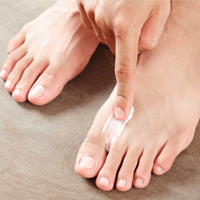Nail Fungus Symptoms and Treatments for Nail Fungal Infection
Having a nail fungal infection is really annoying. Where did it come from? Well, you probably wear your shoes too much or you were walking barefoot in a public swimming pool or are being negligent in using communal comfort rooms. Maybe you haven’t heard of nail fungi and didn’t care until you found them occupying 10 per cent of your feet. It nailed it! Now read this for your awareness:
Nail fungi, onychomycosis (on-i-ko-mi-ko-sis) or tinea unguium in scientific terms, commonly infects the feet because these minuscule fiends love dark and humid spots of the human body. Since our feet spend most of their waking time enfolded in leathers or rubbers and inefficient socks, the fungi often breed in the toenails where there is enough warmth and moisture.
Beware! This kind of fungus is naturally anaerobic. It means that they indulge in environment with less supply of oxygen. It belongs to the dermatophytes family, which also causes athlete’s foot, ringworm, psoriasis, and jock itch among others. Some of the sources of these fungi are yeasts and molds. They thrive in soggy areas and can penetrate our nails through contact with an infected nail or improper hygiene.
At first, the fungus is just a white or yellowish spot under the nail. It then chomps through the keratin compound of the nails and spreads. Soon, you will feel pain while your nail gets brittle and thick with the ugly discoloration. In some cases, the infected area bleeds and develops a gooey discharge.
If you are not diabetic, you’re lucky. People with diabetes could hardly treat nail fungi when infected due to weak immune system and blood circulation conditions. A mild infection leads to greater damage on the course. This is the case also for persons with leukemia.
Normally, nail fungal infection is cured by proper hygiene and medication. Topical and oral treatments are taken in or applied as prescribed by doctors. Antifungal brands can be had over-the-counter such as Lamisil, Tinactin, Penlac, and the like. The medication may take three months or more until a new nail sprouts. However, this does not guarantee your nails to be fungi-free forever. They sometimes recur if triggered.
To prevent nail fungus, you must follow the basic rules in hand and foot hygiene. Keeping your nails dry and clean saves you in the long run. And choose the right socks to wear! Synthetic socks perform better in terms of dryness than cotton-made. Plus, don’t stock your feet too long inside your shoes. Give them short breaks during daytime to keep it ventilated. Foot powder is highly recommended, too. The fingernails rarely acquire nail fungi but to be sure, avoid overexposing it to water or chemicals. If you have to, always dry them thoroughly.



